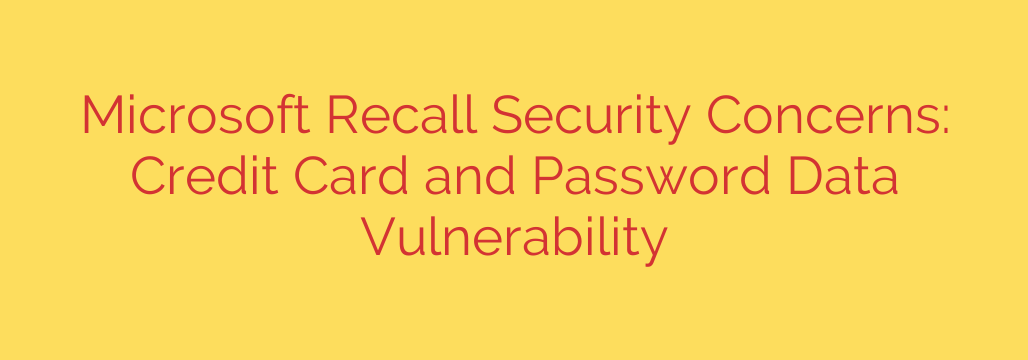
Microsoft Recall: A Privacy Nightmare? Unpacking the Security Risks of Windows’ New AI Feature
Microsoft’s announcement of the new “Recall” feature for Copilot+ PCs promised a revolutionary user experience—a perfect, searchable memory of everything you’ve ever seen or done on your computer. The concept is powerful, but a closer look at its implementation has raised significant security alarms among cybersecurity experts, who warn it could become a treasure trove for hackers.
While the idea of instantly finding a past document or website is appealing, the method Recall uses to store this information presents a serious threat to your personal data. Here’s what you need to know about the vulnerabilities and how to protect yourself.
What is Microsoft Recall?
Recall is an AI-powered feature designed for the new generation of Copilot+ PCs. It works by continuously taking screenshots of your screen every few seconds. These snapshots are then analyzed by a local AI model, making them searchable by text and context. In essence, it creates a detailed, visual timeline of your digital life, stored directly on your hard drive.
The goal is to help you remember things—that recipe you saw last week, a comment in a video call, or a file you briefly opened. However, this convenience may come at an unacceptably high price.
The Core Security Flaw: A Database of Your Entire Digital Life
The primary concern stems from how Recall stores its data. Security researchers have discovered that Recall saves its collected information, including all the screenshots, into a local database on your computer. Shockingly, this database has been found to be stored in an unencrypted, plaintext format.
This means that anyone who gains access to your user account on the computer can potentially access and read this database. It’s the digital equivalent of leaving a detailed, photographic diary of your every action open on a desk for anyone to flip through. All your activities—from typing passwords to viewing bank statements—are recorded and saved in an easily accessible manner.
How Hackers Can Exploit Recall
The attack scenario is disturbingly simple. Hackers don’t need sophisticated, new techniques to exploit Recall. Instead, they can rely on existing methods like phishing emails, malicious downloads, or other forms of malware to gain initial access to a user’s machine.
Once a standard piece of malware is on your system, it can perform a devastating new task: locate and steal the entire Recall database file.
Previously, a malware infection might allow a hacker to install a keylogger to see what you type from that moment on. With Recall, they get something far more valuable: a complete historical record of everything you’ve ever done. This turns a routine security breach into a catastrophic data leak, handing over months of sensitive activity in a single file.
What Sensitive Information is at Risk?
Because Recall captures your screen indiscriminately, virtually any information that appears on your monitor is vulnerable. This includes:
- Passwords and Login Credentials: Especially if you use the “show password” feature.
- Credit Card Numbers: Entered during online checkouts.
- Financial Information: Viewed on banking websites or in financial documents.
- Private Messages: From applications like Signal, WhatsApp, or Teams, including “disappearing” messages.
- Confidential Documents: Sensitive work files, personal records, and medical information.
- Security Question Answers and PINs: Typed into recovery forms or login prompts.
Essentially, if it crosses your screen, Recall stores it and a hacker can potentially steal it. This makes every Copilot+ PC with Recall enabled a high-value target for cybercriminals.
Actionable Steps to Protect Your Data
Given these significant risks, taking proactive steps is crucial.
Disable Recall Immediately: The most effective way to mitigate this threat is to not use the feature at all. Until Microsoft implements robust, end-to-end encryption and fundamentally redesigns its security, the risk is too high for most users. You can typically disable it by navigating to Settings > Privacy & Security > Recall & snapshots and turning the feature off.
Enhance Your Overall Security Posture: If you choose to use a Copilot+ PC, your general security habits become more critical than ever. Ensure you have a top-tier antivirus or anti-malware solution installed, be extremely vigilant about phishing emails, and avoid downloading software from untrusted sources.
Be Mindful of What You Display: Even with other security measures, it’s wise to assume anything on your screen could be recorded. Avoid having multiple windows with sensitive information open simultaneously, and be cautious when typing in passwords or financial details.
While the promise of a perfect digital memory is compelling, the current implementation of Microsoft Recall appears to prioritize features over foundational security. For now, the safest choice is to keep it turned off and protect your digital life from being served up on a silver platter to the first hacker who breaks in.
Source: https://go.theregister.com/feed/www.theregister.com/2025/08/01/microsoft_recall_captures_credit_card_info/








